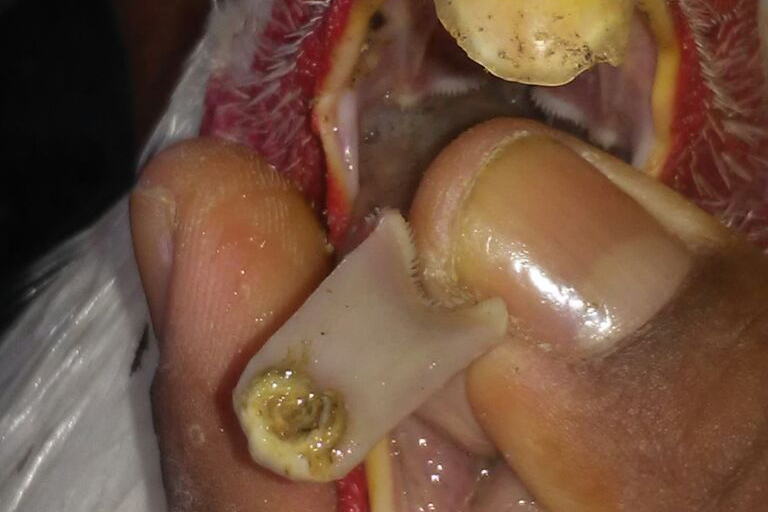Mycotoxicoses in poultry: A manageable problem

These days poultry diets contain much higher inclusion of maize and maize byproducts of DDGS than in the past. This information forces us to think about how feed containing medium to high concentration of fusarium mycotoxins will affect poultry.
Earlier experiments, conducted for short periods or using single purified compounds, showed that poultry were resistant to DON. More recent experiments, utilising naturally contaminated grains fed to poultry for extended periods, have shown that combinations of fusarium mycotoxins pose significant risks to poultry performance and health. Contamination of animal diets with DON can result in great economic losses for animal production.
Impact of DON on poultry growth
In poultry, it was shown that the impact of DON on growth performance is highly variable (reduced feed intake, weight gain and feed efficiency), due to differences in strains of poultry and diets used. Chickens are considered to be less sensitive compared to other species. This can be attributed to differences in DON absorption, distribution, metabolism and elimination (Pestka et al., 2005), in addition to the hypothesis of a protective effect of the renal first pass effect, which exists in chickens (Rotter et al., 1996).
The first pass effect is mediated by different gastrointestinal and hepatic enzymes that result in the oxidation, reduction or hydrolysis (phase I reactions) and/or conjugation (phase II reactions) of toxins. This metabolism of orally administered mycotoxin results in a significant reduction of the amount of un-metabolised DON reaching the systemic circulation.
Chickens resist DON due to the low level of absorption into plasma and tissues in addition to rapid clearance (Prelusky et al., 1986). A limited oral absorption and rapid plasma clearance of DON was found in turkeys (Gauvreau 2000). The intestinal microflora can convert DON to de-epoxy DON (DOM-1) in birds (He et al., 1992).
Whereas the degradation of the epoxide group by reductive cleavage of the toxic 12, 13-epoxy ring is carried out by intestinal microflora in chickens. However, in the absence of clear clinical symptoms, DON can induce reduced feed intake, which cannot be separated from the direct effect of DON contamination itself on immunity, hematology and health parameters (Rotter et al., 1996). Turkeys appear to be more sensitive to fusarium mycotoxicoses than chickens, while ducks have shown to be the most resistant poultry species.
Are turkeys sensitive to fusarium mycotoxins?
Turkeys are more sensitive to fusarium mycotoxins than other avian species. Earlier reports suggested that turkey poults could tolerate 5 mg/kg DON in naturally contaminated wheat based diets without any significant changes in feed intake or body weight gain (Hamilton et al., 1985). However, increasing proportions of artificially contaminated wheat in turkey diets up to 5.4 mg/kg DON and 0.4 mg/kg ZEN resulted in a dose dependent decrease in body weight gain (Dänicke et al., 2007).
Even lower levels of DON, combined with 15-acetyl-DON and ZEN, in naturally contaminated diets caused decreased body weight gain, increased plasma uric acid, and increased relative weight of the gizzard and bursa of Fabricius (Girish et al., 2008b). Feeding highly contaminated grains to turkeys for 12 weeks reduced growth rates in all growth phases. Body weight gain decreased as early as the third week of feeding (Chowdhury and Smith, 2007).
Fusarium mycotoxins affect cell-mediated immunity more than humoral immunity. Deoxynivalenol can induce changes in brain neurochemistry which may be related to altered behaviour and emotional stress in turkeys. Comparable findings in brain neurochemistry have been described in layers fed naturally contaminated diets (Yegani et al., 2006). Feeding naturally contaminated diets containing 3.3 mg/kg DON, and lesser amounts of 15-acetyl-DON and ZEN, reduced villus heights in the duodenum of turkey poults in the starter phase and in the jejunum in both the starter and grower phases (Girish and Smith, 2008). These birds had reduced growth rate (Girish et al., 2008b). To conclude, the main negative effects of fusarium mycotoxins in turkey are decreased daily weight gain, lower final weight and finally worse FCR.
Successful mycotoxin solution in turkey
In the currently described experiment 1596 one-day-old Hybrid tom turkeys were randomly placed into 38 floor pens (42 poults/pen). Each pen was assigned to 1 of 5 treatments in a randomised complete block design with pen blocked by room and location within room. Basal feed was prepared using uncontaminated or naturally contaminated maize. The treatments were applied to a standard turkey starter diet (Table. 1).
The treatments were applied to a standard turkey starter diet. Turkey poults and feeders were weighed by pen at placement, and then once per week throughout the 5-week trial. Data was analysed by ANOVA with contrasts used to compare the DON treatment to each of the 3 products.
Turkey’s fed the Unike Plus treatment consumed more feed compared to those that were fed the DON contaminated diet (Figure. 1; P<0.05). however, feed consumption of birds fed products a or b was not different from the don treatment (p>0.10). With higher average daily feed intake, birds assigned to the Unike Plus treatment had higher average daily gain and higher final body weight compared to the highest DON treatment (Figure. 2; P<0.10). the rate of average daily gain and body weight of turkey fed the other 2 additives (products a or b) were not different from the high don diet. there were no statistically significant differences in feed efficiency between treatments (>Figure.2).</0.10).></0.05).>
This trial demonstrated the negative influence that DON (and possibly other trichotecenes) has on feed consumption and the subsequent impact this has on the feed intake and growth in young turkey poults. The mycotoxin deactivator Unike Plus reduced these negative effects and clearly performed better than 2 other common brands of mycotoxin deactivators.
This year, special attention should be paid to contamination of feeds by DON and ZEN and appropriate measures taken to mitigate against the effects of their presence in animal feeds. The last possible line of defence is the detoxification of mycotoxins in vivo. The addition of proven mycotoxin deactivators to animal feeds is a very common method to prevent mycotoxicosis and is an effective strategy to keep mycotoxin risk low under any and all conditions.
References available on request











